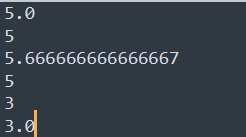Python 变量和简单数据类型 2
1. print 打印
print("Hello Python world!")
2.变量
message = "Hello Python world!" print(message)
3.字符串 可以是单引号也可以是双引号
"This is a string." 'This is also a string.'
4.字符串大小写转换
name = "Ada Lovelace" print(name.upper()) print(name.lower())
5.字符串中使用变量 f代表format
first_name = "ada" last_name = "lovelace" full_name = f"{first_name} {last_name}" print(full_name)
6.字符串中添加制表符,可使用字符串组合\t
c="\tabc" print (c)

7.字符串 换行使用\t
print("Languages:\n\tPython\n\tC\n\tJavaScript")

8.字符串去空白(依次是去右边,去左边,去两边)
favorite_language=' pyhton ' str1=favorite_language.rstrip() print(str1) str2=favorite_language.lstrip() print(str2) str3=favorite_language.strip() print(str3)
9. 整数
# 整数 a=2; b=3 print(a+b) #整数没有限制大小 a=11121212132123123123223423423423423432423 b=23423423423423423423423423423423423423423 print(a+b) #转整数 c="23" d="23" print(int(c)+int(d))

10.浮点数
#浮点数 a=0.2; b=0.1 print(a+b) #转浮点数 c="1212.12" d="1212.12" e=float(c)+float(d) print(e)

11.常量
在高级语言中,常量类似于变量,但值在程序整个生命周期内保持不变, python是没有内置的常量类型,但开发时可能需要, 定义常量时,约定变量名用大写视为常量,当开发人员看到大写的变量时,就不去重新赋值,这是一种约定。
MAX_CONNECTIONS=5000
print(MAX_CONNECTIONS)
12.数字下划线
#数字下划线,更好的可读性,python3.6+支持 universe_age=14_000_000_000 print(universe_age) 输出 14000000000
13.除法运算符 / 和 // 介绍
#除法/总是返回一个浮点数,如果只想要整数,使用运算符// a=10; b=2 print(a/b) print(a//b) #整数除法返回浮点型 print(17/3) #返回整数 print(17//3) #注意使用 //运算符时, 只有整数与整数运算才能返回整数,否则返回浮点数 print(7//2) print(7.0//2) print(7//2.0)

14.bool 布尔类型
a=True b=False if a!=b: print('不相等') else: print('相等')

15.字符串截取
下面一段代码是截取token值
body='"hello": getSearchToken("1","6jQFmiGx9FOZ2iubiELVukGjhtiqN5aPA468wlEcaVrD9IUdZ4"),' start=body.find('getSearchToken') if start==-1: print('未找到getSearchToken!') start+=20 end=start+53 newbody=body[start:end].replace('"),','') print(newbody)

16 查看字符串编码
下面自动化转成16进制,再转成10进制,最后再转成2进制
可以发现 “自”的二进制为: 11101000 、10000111、11100101
Python 3.13.5 (tags/v3.13.5:6cb20a2, Jun 11 2025, 16:15:46) [MSC v.1943 64 bit (AMD64)] on win32 Type "help", "copyright", "credits" or "license" for more information. >>> name="自动化" >>> v1=name.encode("utf-8") >>> v1 b'\xe8\x87\xaa\xe5\x8a\xa8\xe5\x8c\x96' >>> >>> v1[0] 232 >>> v1[1] 135 >>> v1[2] 229 >>> bin(232) '0b11101000' >>> bin(135) '0b10000111' >>> bin(229) '0b11100101' >>>

 浙公网安备 33010602011771号
浙公网安备 33010602011771号